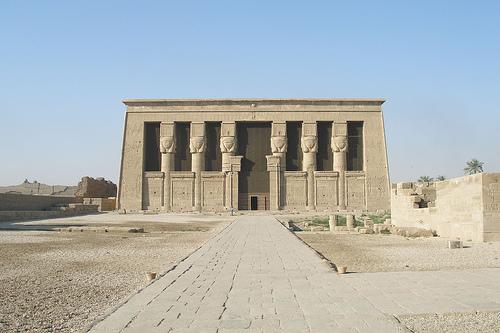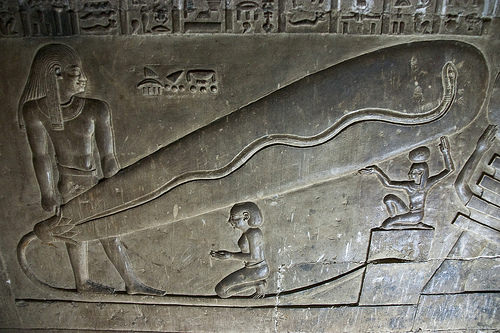

Location: 5 km (3 mi) Southwest of Qena, Qena Governorate Map
Open: 6am- 4pm daily
Dendera Archaeological Site is ancient Egyptian archeological site
situated 5 km (3 mi) Southwest of Qena, Qena Governorate in Egypt.
This enormous temple complex covers a total area of 40,000 square
meters. The first religious structure was constructed here by
pharaoh Pepi I in the middle of the 23rd century, however little
remains from the time period. Some of the best preserved buildings
on the site actually date back to the Greek and Roman times.
One of the most famous reliefs originally found here is a relief of
a Dendera zodiac that contained images from astrology and pagan
religions. A sketch of the beautiful depiction was made by the
French archeologists during Napoleonic campaigns in Egypt in the
late 18th century. Unfortunately the relief itself was removed in
1820 and moved to Louvre museum in France. Dandera zodiac date back
to the first century BC when the land was ruled by the Greek dynasty
of Ptolmeic family.
The history of the place began in the predynastic period. This is
documented by an ancient cemetery not far from the walls around the
Hathor Temple.
Dendera was the capital of the sixth district of
Upper Egypt, the local goddess was Hathor. The plan of the main temple
goes back to Cheops. Pepi I later restored her temple.
By the
time excavations began, half of the temple was submerged in desert sand,
which saved many of the frescoes from iconoclasm and vandalism. The
upper rooms were used as stables and houses with open fireplaces, which
is why the ceilings are still blackened with soot and the former
painting cannot be reconstructed.
Necropolis
Behind the city, in the desert, there is an extensive
cemetery. Various excavations here revealed large mastabas from the late
Old Kingdom and the 1st Intermediate Period. Some of these graves were
richly decorated with inscriptions and are a valuable source for this
period. Other grave complexes date from the Ptolemaic and Roman periods.
Temple of Dendera
Enclosure walls
Originally there were three
enclosing walls in the district of the goddess Hathor, of which only the
one for the large Hathor temple is well preserved. It is just over 290 m
long and 280 m wide, has a base width of between 10 and 12 m and reaches
a height of 10 m.
Hathor Temple
Particularly famous is a
temple dedicated to Hathor, which was built during the 6th Dynasty and
was later rebuilt. It is oriented north-south and faces the Nile. It
received its visible form, as a copy of the ancient sanctuary, under the
last Ptolemies and the first Roman emperors. Construction work on the
temple began under the Ptolemies and was only completed by the Romans.
The building, which took 200 years to complete, is well preserved
and distinguished by the uniqueness of its architecture as well as the
richness and clean execution of the images and hieroglyphs. Walls and
columns are completely covered with fine sculptures. The wall sculptures
inside depict the emperors Augustus, Tiberius, Claudius and Nero making
sacrifices in the ancient Egyptian style.
The path leads through
the portal into an imposing hall that was begun under Augustus and
completed under Nero. It is supported by 24 columns in four rows and is
27.5 m high and 43 m long inside. This is followed by three halls of
different sizes and an adyton surrounded by eleven cells. The entire
temple is 81 m long and 34 m wide. The excavation of the Hathor Temple
began in 1875 by Johannes Dümichen.
Sanctuary of Isis and Mammisi
Next to the western corner of the large building there is a small
sanctuary of Isis, completed under Nero, with a dromos 170 paces long
leading to the pylons. 90 steps north of the sanctuary of Isis is the
Mammisi (birth house), formerly incorrectly called Typhonium, dedicated
to Hathor.
Other facilities
To the west of the temple lies the
sacred lake, which is covered with palm trees. The underground tunnel to
the Nile is still intact and the water level can be checked in one of
the two tunnel entrances, which is why this device is also called a
Nilometer.
Behind the great Temple of Hathor are the Temple of
Isis and the Typhonia. The Temple of Isis is very small and stands
behind the western corner of the Temple of Hathor. It was built and
decorated under Augustus. The second, larger temple stands to the north
of the Hathor Temple and was built under Trajan. Some depictions there
date from the time of Hadrian and Antoninus Pius.

In Egyptology, a group of motifs that can be seen in several places
in the Temple of Hathor is interpreted as a representation of the “god
on the flower”.
Some also refer to this group of motifs as the
“bulbs of Dendera,” which gives rise to parascientific speculation on
the question of whether the ancient Egyptians knew about electric light
in the form of incandescent lamps.
During Napoleon's expedition, two famous zodiacs were found on the
ceiling of the hall of the main temple in addition to the gigantic
figure of the sky goddess Nut (hence also called the Celestial Hall),
one of which was sawn out by a Frenchman in 1820 and has been in the
Egyptian department of the Louvre since 1822 is exhibited in Paris.
France later had a copy made for Egypt.
In this zodiac, Leo
appears as the initial sign after the intersection of the ecliptic and
the Earth's equator. However, the location of the solstice (solstitium)
depends on the location of these average points, which must always be in
the middle of both. On the Dendera zodiac he is recorded in Cancer. From
this deviation from the current position of the sun, scientists believed
they could deduce the age of this zodiac. There was only one difference
depending on whether that solstice was viewed as the winter or summer
solstice.
The dispute over this has given rise to a wide variety
of claims, such as: B. Fourier describes the creation of the same
between 2500 BC. and 2100 BC, Lalande around 1300 BC. or 1200 BC, Biot
not before 716 BC and Visconti not before 328 BC sets. The discoveries
of Jean-François Champollion put an end to this speculation.
According to the Louvre, it dates back to 51 BC. estimated as Ptolemy
XII. (Theos Philopator Philadelphos Neos Dionysos) rebuilt it, as the
crypts of the House of Commons show. Some of the depictions come from
the reign of Queen Cleopatra, who is depicted on the outer back wall of
the temple together with her son Caesarion in a 4 m high figure.
The temple's porch, which contains the second zodiac, was built between
32 and 37 AD by the residents of Tentyra under Emperor Tiberius. The
wall sculptures of the rear temple were made in the reigns of Cleopatra
and Augustus, those of Pronaos under Tiberius, Caligula, Claudius and
Nero.